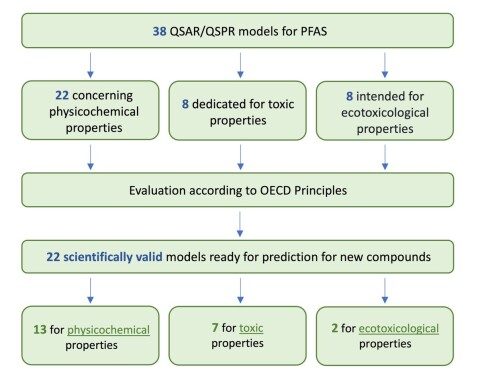Towards higher scientific validity and regulatory acceptance of predictive models for PFAS

Fig. 1 Quantitative Structure-Activity/Property Relationship – QSAR/QSPR – in silico approach.
19 May 2023
There are nearly 5000 PFAS that have been registered and/or produced, resulting in their widespread presence in the environment. But what impact do these chemicals have on human health and the environment? And how can this impact be assessed? QSARLab wants to find out more and has analzyed 38 in silico QSAR/QSPR models in a study.
Properly developed QSAR/QSPR (quantitative structure-activity/property relationship) models can be used to assess the impact of PFAS on humans and the environment. QSAR/QSPR models relate the chemical structure of compounds (X) with the response variables (activity/property) (Y) (Fig. 1). The chemical structure (variables (X)) is presented in numerical form through molecular descriptors such as molar mass, number of atoms, number of bonds, number of aromatic rings, hydrophobicity, etc. A properly developed QSAR model should be characterized by a good fit to the training set, robustness, and defined predictive ability. Such a model can be used in the next step to predict the property (Y) of the new compound (which was not used to develop model (Z)), based on its structural features (descriptors(X)).
In a study, QSARLab assessed 38 in silico models developed for PFAS which are available in the literature. These models mainly concern physicochemical (22) but also toxic (8) and ecotoxic (8) properties (Fig. 2). The evaluation of the models was carried out based on (Q)SAR Model Reporting Format (QMRF) – a document that considers all the OECD principles about a properly prepared QSAR model. For example, the QSAR model needs to define the endpoint and the domain of applicability. During the analysis, we identified 22 models as scientifically valid (Fig. 2) and which could be used in the prediction of activity/properties of new compounds.
The study shows two significant issues when analyzing the available predictive models dedicated to PFAS:
- Existing models are very limited in helping to characterize or assess the environmental fate and transport of PFAS. There is still a need to develop predictive, scientifically valid models for all partition coefficients (octanol-water, air-water, air-octanol), degradation rates (biodegradation, abiotic degradation, photodegradation), soil toxicity as well as bioconcentration factors for the whole group of PFAS compounds.
- QSAR models available in the literature mainly focused on acute toxicity (EC50 or LC50). Nevertheless, they do not indicate a clear relationship between the structure of the PFAS and the adverse outcome pathway and molecular initiating events. They only explain the basic structure or activity relationship (statistical approach) but do not indicate the real mechanism of action.
According to the analysis conducted, it is recommended that the issues mentioned above should be taken into account in the further development of predictive models to make them valuable and applicable in the human and risk assessment of PFAS compounds.
Find the study here.

Fig. 2 Workflow on searching and evaluation of the available QSAR/QSPR models with the distinction of the category of properties to which they are dedicated.
Image source: QSARLab
